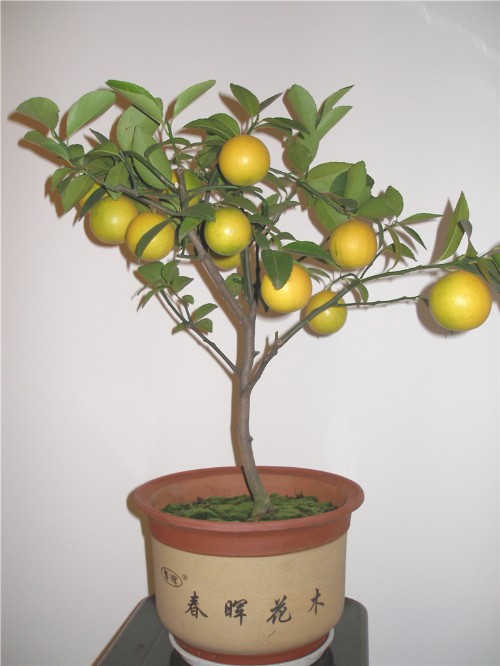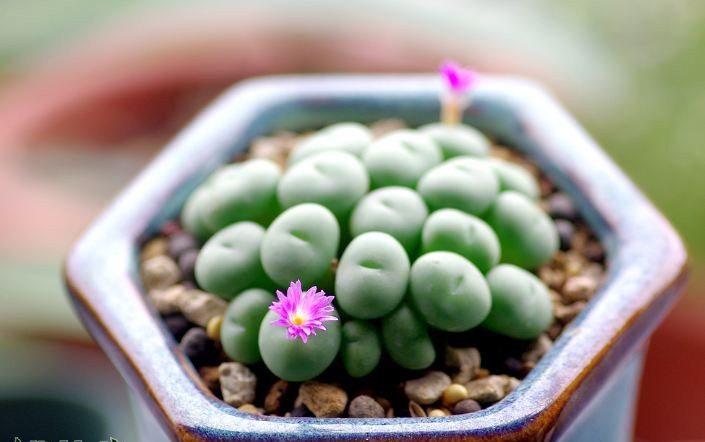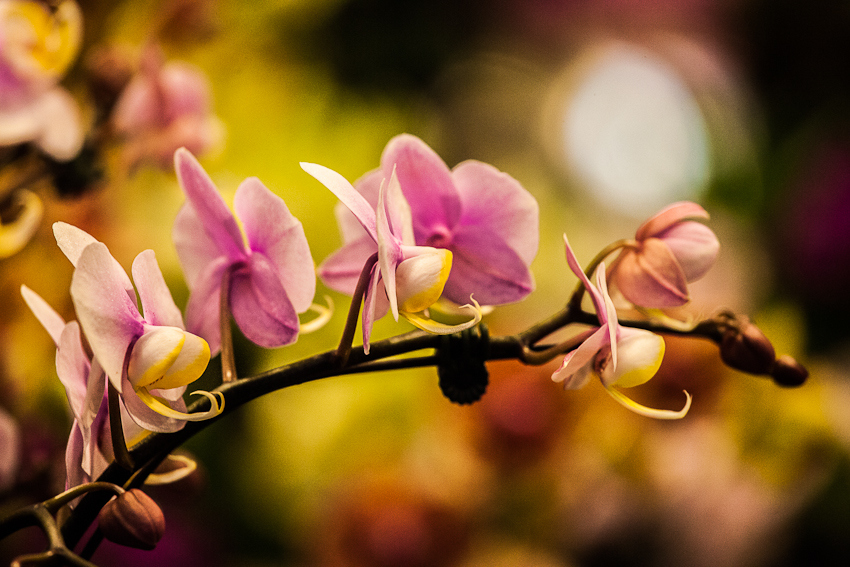Methods and techniques of potted lemons
Lemon is a small evergreen tree of the genus Citrus of Rutaceae. Leaf blade small, long oval, leaf margin serrulate. Flowers are solitary,-blooming all the year round with rich aroma. The fruit is oval or ovate and ripens in autumn and winter. The peel is yellow, the pulp is very sour and fragrant, the fruit juice is citric acid, and the peel can extract lemon oil.
Lemon pot cultivation techniques are mainly as follows: large amount of seedlings and pot cultivation in the south, suitable for grafting propagation; less cultivation in the north, mainly using cutting methods, and grafting seedlings can also be purchased. The root system of lemon has higher requirements for water, nutrients and soil, and the pot soil should be made into water and air permeability, water and fertilizer conservation, and slightly acidic culture soil. The time of putting on the basin and changing the basin is available after autumn and early spring, and can be flexibly controlled according to the local climate.
Light and temperature lemon is a light-loving plant, but if the sun is too strong, it will have poor growth and development. At noon, the plant needs to be replaced at an annual average temperature of more than 15 degrees Celsius, the best growth temperature is 23 degrees Celsius to 29 degrees Celsius, more than 35 degrees Celsius to stop growth,-2 degrees Celsius will be frozen. Lemon summer-like no need to cool down, enter the room before Frosts Descent, leave the room after Qingming Festival, can survive the winter safely.
Watering and fertilizing lemons need more water in their growth and development, but too much water is not easy to rot their roots. Generally speaking, spring is the time for shoots and leaves to spread and bud to blossom, and it should be watered appropriately. The summer light is strong, the temperature is high, needs more water. However, it should be timely and appropriate, otherwise it will cause fruit drop. Autumn is the period of shoot growth and rapid fruit expansion, so there must be sufficient water. Late autumn and winter are the period of flower bud differentiation, while the basin soil is dry. Lemon prefer fertilizer, in addition to the basin, change the basin to apply sufficient base fertilizer, the growth period should adhere to the principle of thin fertilizer and frequent application. The times and amount of fertilization should be determined according to the growth and phenological period. For example, it is better to apply liquid fertilizer to fully fermented cake fertilizer and water, and the ratio of cake to water is 1VR 200. The soil in the north is slightly alkaline, so ferrous sulfate can be added to the fertilizer solution to form a slightly acidic nutrient solution.

Pruning-generally divided into winter shears and summer shears. Winter shearing should be based on the principle of "cutting density and keeping thinning, getting rid of weak and strong", cutting off withered branches, cutting weak branches and overgrown branches without the effect of initial space. Summer pruning mainly truncates the overlong branches on the fruitless tree, erases the summer shoots on the fruiting tree, and shortens the declining branches in the middle and upper part of the crown. Lemon for promoting flower and protecting fruit is the tree species that blossom and bear fruit in the four seasons, while the potted plants in the north mostly blossom and bear fruit in spring. Therefore, it is necessary to control the water after the autumn shoot stops growing. Wait for both sides of the leaves to begin to roll, and then moderate watering to promote flower bud differentiation. Pay attention to fertilization in the basin and foliar spraying to cultivate robust fruiting mother branches. How to plant lemons with lemon seeds? Methods, steps and techniques of Lemon potted plants
When it comes to lemons, I believe everyone will be familiar with it. Lemons are a good choice for detoxification and beauty-preserving fruit. It can not only taste sour, sweet and delicious, but also has a good health effect, so it is deeply loved by everyone. So, do you know how to grow lemons with lemon seeds? Today, the editor will give you a detailed introduction.
First, it is necessary to select fully naturally ripe lemon fruit, there is no completely naturally ripe lemon fruit, the germination rate of its seeds is relatively low, and it is not easy to survive after germination.
Second, after taking out the lemon seeds in the fruit, select the relatively full, large and complete lemon seeds, and choose as many lemon seeds as possible to prevent some lemon seeds from sprouting.
Third, wash the film off the lemon seed by hand and be careful not to hurt the budding point of the seed, which is the sharp part of the seed. You can also remove the shell of the seed, but this is usually not necessary or recommended, because it is more likely to hurt the budding point when removing the shell.
Fourth, soak the lemon seeds in clear water and transfer them to a warm place to avoid light and sprout. It will take about a week to soak, during which time you should pay attention to changing the water once a day. Another lazy way is not to soak. It is OK to plant lemon seeds in flowerpots directly.
Fifth, after soaking for a week, you can plant the lemon seeds in the flowerpot, and then pay attention to watering every day to keep the soil moist. The planting density of seeds can be slightly higher, and the soil should be fertile and loose and breathable.
After waiting for another week or so, you should be able to see the lemon seeds turn into seedlings and get out of the soil. After waiting for the seedlings to grow for a period of time, we can clean up the weaker seedlings, leave more plants if you like to be dense, and leave fewer plants if you don't like those that are too dense. I hope that only one will bear fruit in the future.
That's all I know about lemons today. I hope it will be helpful for florists to read this article. If you want to know more about lemons, please continue to follow the succulent flower beds and we will provide you with more related knowledge!
Planting vanilla | Family potted planting techniques of lemon verbena alias lemon verbena, deodorant wood, perfume wood, verbena family. The whole body is filled with a strong aroma like lemon, which is why it got the name "lemon vervain". It has strong health care effect and is a good variety for family potted planting. Lemon verbena has the effect of promoting digestion, relieving nausea and flatulence, calming and relaxing. Drinking when a cold causes fever is not only beneficial to recovery, but also relieves throat and nose discomfort. Have the effect of reducing stress, can make people feel relaxed, and sleep in a soothing atmosphere! Mixed with herbal tea, in addition to healthy detoxification, light weight, weight loss, but also calm the mind, relieve pressure, is the best match for office workers and people who stay up late. Lemon verbena essential oil has a mild calming effect and can help sleep. It is also known for its effect on relieving depression because it regulates and soothes the parasympathetic nervous system. Without much gossip, here are some precautions for potted plants:
1. The growth environment of lemon verbena requires 1. Planting season: suitable for spring and autumn cultivation 2. Temperature requirements: like warmth, not hardy 3. Lighting requirements: like sufficient sunshine, full sunshine 4. Humidity requirements: not resistant to waterlogging 5. Soil requirements: loose, fertile, well-drained sandy loam 6. Common diseases and insect pests: red spider II, lemon vervain planting skills 1. Mixed soil sowing potted lemon verbena can be mixed with peat soil, perlite, river sand and appropriate amount of organic fertilizer to form nutritious soil. Spread the seeds evenly in the soil, cover a thin layer of soil slightly, and water thoroughly. two。 The seedlings should be well ventilated after transplanting, and the temperature should be controlled at about 20 degrees. When the seedlings grow to 3 to 5 centimeters high, they can be used in the flowerpots of traditional Chinese medicine. 3. Watering lemon verbena avoid waterlogging, when the basin soil dries, then watering, watering should be timely drainage, to avoid stagnant water in the basin. Be careful not to water the leaves and flowers directly when watering. 4. Pruned lemon verbena grows rapidly and needs to be pruned frequently to promote new branches. The withered and yellow branches and leaves should be cut off in time in order to maintain good ventilation and reduce diseases. 5. Harvest tender stems and leaves in spring, plant growth is exuberant in summer, fresh leaves and shoots can be harvested, harvesting can be combined with pruning. The fresh leaves harvested are most suitable for making tea and can also be preserved after drying. 6. The propagation of lemon verbena can also be propagated by cutting. in the spring and autumn, the sturdy branches are cut and planted in the well-drained cutting substrate, shaded and maintained, and then transplanted into the flowerpot after the branches take root. Vanilla planting Lemon Verbena is an all-day plant, but it also needs proper shade when it is hot in summer to avoid exposure to the sun. Pay attention to the cold in winter, can put eggshells in the basin, hay to protect against the cold.
- Prev

Maintenance methods and skills of group Jasper
Group Jasper is a small and delicate succulent plant, Amygdaceae succulent flower genus, plants in groups, with extremely fleshy opposite leaves, green, unpatterned, flat top, shallow seams in the center, purple-red flowers bloom from shallow seams in autumn, a single flower can bloom for 5 to 7 days. Group Jasper originated in South Africa and began in autumn.
- Next

How to raise orchids in autumn
In autumn, when the temperature decreases, the growth of orchid plants slows down, the water demand decreases, and the substrate can be kept wet. In order to make the root grow healthily, the substrate should not be too wet and too fat. Too wet will damage the root system, which in turn will damage the whole orchid plant. The root of an orchid is fleshy, stout, and intolerant to flooding.
Related
- Fuxing push coffee new agricultural production and marketing class: lack of small-scale processing plants
- Jujube rice field leisure farm deep ploughing Yilan for five years to create a space for organic food and play
- Nongyu Farm-A trial of organic papaya for brave women with advanced technology
- Four points for attention in the prevention and control of diseases and insect pests of edible fungi
- How to add nutrient solution to Edible Fungi
- Is there any good way to control edible fungus mites?
- Open Inoculation Technology of Edible Fungi
- Is there any clever way to use fertilizer for edible fungus in winter?
- What agents are used to kill the pathogens of edible fungi in the mushroom shed?
- Rapid drying of Edible Fungi

